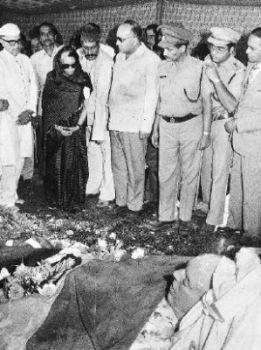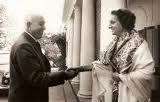Peace Watch » Featured, Kashmir-Talk » Indira-Sheikh Agreement 1975 Revisited
Indira-Sheikh Agreement 1975 Revisited
INDIRA-SHEIKH ACCORD
ABDUL MAJID ZARGAR
The Indira-Sheikh accord of 1975 is in news once again. Speaking on the sidelines of a function “Sakshaar Bharat Yatra” organized by JK Bharat Vigyan, Dr. Farooq Abdullah, the union Minster of New & renewable energy has said that nothing was settled in 1975 accord. Earlier his brother Dr. Mustafa kamal stated that the accord was not signed by Sheikh Mohd. Abdullah blissfully forgetting that his father assumed the chief Minstership of the state pursuant to this accord only. On the other hand the State Congress leaders believe that Centre-State relations were well defined & settled in 1975 accord thus treating the matter as closed & further concessions as non-negotiable.
It is, therefore in the fitness of things to revisit the accord which was preceded by Beg-Parthasarthy talks spanning over almost three years. Before the start of these talks, Mirza Mohd. Afzal Beg thought it appropriate enough to make it known that Plebiscite was no longer an issue. The dispute with New-Delhi was over the quantum of autonomy. This was confirmed by Sheikh Mohd. Abdullah in an interview to London Times on 8th March 1972.
On 24th March 1972, Indira Gandhi informed Parliament that she welcomed the change in the thinking of Abdullah for having expressed his willingness to accept the finality of Kashmir accession. Thus started the process of negotiations between Parthasarthy & beg, the former representing Indira Gandhi & the latter Sheikh Mohd. Abdullah. Beg began by asking for the transfer of the fundamental rights provisions of the Indian Constitution to the J&K Constitution. He also demanded removal of the authority of the Election Commission and abrogation of article 356 to prevent arbitrary imposition of President’s rule. None of these were accepted and as Indira Gandhi informed Parliament later on 24th Feburuary 1975 that it was not found possible to agree to any of these proposals and relations between Kashmir & Indian Union would continue as before. In the same breath she praised Abdullah as a statesman having strong views on these issues but nevertheless having agreed to drop them in broader national interests .Beg-Parthasarthy talks finally culminated in an agreement, known as agreed conclusions, which was signed on 13th November 1974 and forwarded to principal parties, Indira & Abdullah for final approval & taking it to its logical conclusion.
The salient features of the agreement were that Article 370 was retained and so were the changes made after 1953 to reduce kashmir’s autonomy. The State Could, however, review post 1953 legislation on the concurrent list which would be sympathetically considered by the President. The key provision enabling the centre to appoint Governor under article 356 was unaffected. The agreement further provided that Parliament will continue to have power to make laws relating to prevention of activities directed towards disclaiming, questioning or disrupting the sovereignty and territorial integrity of India or bringing about cession of a part of Indian territory. There was no agreement on restoration of nomenclature of Wazir-i-Azam & Sadr-i-Riyasat which was left to the decision of Principal parties. Incidentally Sheikh had earlier informed Parthasarthy, through a confidential letter dated 23rd August 1974 that he will not assume seat of power unless 1953 position is reverted to implying thereby restoration of nomenclatures for Chief Minster & Governor as Wazir-i- Azam & Sadr-i- Riyasat respectively (Noorani-Constitutional History page 403)
While the stage now shifted to principal parties, It soon dawned upon Abdullah that it is impossible to gain anything substantial on Autonomy even after jettisoning the plebiscite slogan. Having burnt his boats by publicly dropping the plebiscite demand, Abdullah was in no position to resist. The long period in Jail had made him tiresome. He now liked a family life and his family liked good things of life. Both he & Beg were getting in on age and temptation to return to position of power & prestige was pressing. An exchange of letters on February 12, 1975 finally clinched the deal on the basis of the Agreed Conclusions.
Two people who played a key role in the eventual rehabilitation of Sheikh Abdullah in mainstream politics were D.P.Dhar & P.N. Haksar. In an earlier note dated 28th December 1974, Dhar told the Prime Minster Indira Gandhi that Abdullah wanted an election in March 1975 as the mechanism for becoming Chief Minster( M.J.Akbar Behind the vale -page 186). But Abdullah was not allowed this luxury. He was, instead offered to head a congress supported Ministry for which Syed Mir Qasim was persuaded to resign to pave way for him. Indira Gandhi had two possible reasons to do this. One to Keep Abdullah continuously on tenterhooks and second not to allow him to gain much popularity, by winning an election, to the detriment of Congress interests in the State .
Abdullah was finally sworn in as Chief Minster of the State on 25th Feberuary 1975 but not before some hiccups. Indira Gandhi’s statement in Parliament of 24th Feburuary that relations between Kashmir & Indian Union would continue as before, was broadcast by All India Radio repeatedly till the swearing Ceremony was scheduled to begin in Jammu. This caused widespread demonstrations & anger in Srinagar condemning Indira-Sheikh accord. Sheikh was livid with rage & did not turn up for swearing ceremony .In his opinion, New-Delhi had belittled his position by giving an impression that he had sold Kashmir for the chair of a Chief Minster. Indira instructed Mir Qasim, the outgoing Chief Minster, to placate and persuade Abdullah to take the oath and in case of his failure to turn-up within half an hour, to himself substitute for Abdullah & take the oath. The decision was conveyed to Abdullah who took the hint and as they say-rest is history.
For Abdullah the plebiscite phase was finally over. He accepted the ratification of accession by the J&K Assembly under Bakshi. He even conceded the right of being called as Wazir-i- Azam, when Indira told him that the clock cannot move backwards. The slogan “Rai Shumari Fowran Karaon” was buried for ever and the political struggle spanning between 1953-75, was referred to as political maundering (Siyasi Awargardgi) insulting the sacrifices of countless people who had gifted their life & treasure for the cause. Pakistan too was shocked with Sheikh’s somersault and Prime Minster Bhutoo gave a call for Hartal which was widely observed in the valley.
The Indira-Sheikh accord, generally viewed as a sell-out of Kashmir cause by Abdullah did restore the power chair to him but it brought him at par with ordinary politicians like Sadiq & Mir Qasim. It is worth mentioning here that Abdullah never disputed the contents of the accord during his lifetime. He assumed power, enjoyed it and then passed it on to his son solely because of the accord. That being so it does not behoove of his inheritors to say now that nothing was settled in 1975 accord. That right vests with people who were not part of the accord.
(The author is a practicing Chartered Accountant. Feed back at amzargar1@indiatimes.com)Filed under: Featured, Kashmir-Talk










Thanks you nice column By Mr Majeed.
And the mighty lion of Kashmir bit the dust for the Indian crumbs. So sad.
Nice Column, Thanks Zahid G Muhammad.
Pleasure